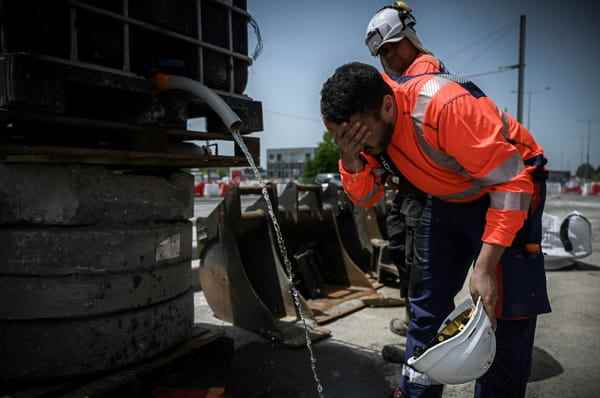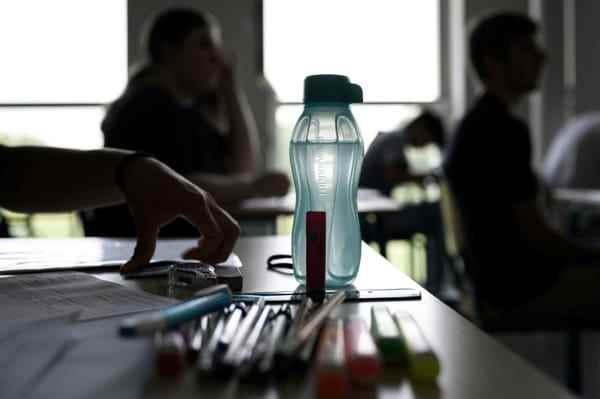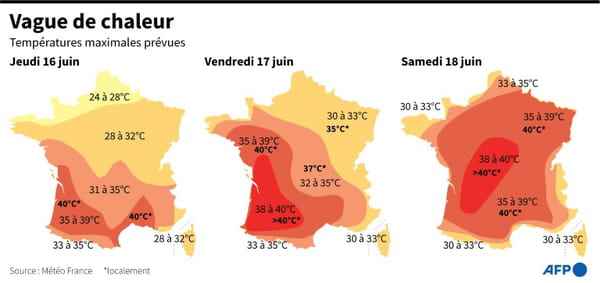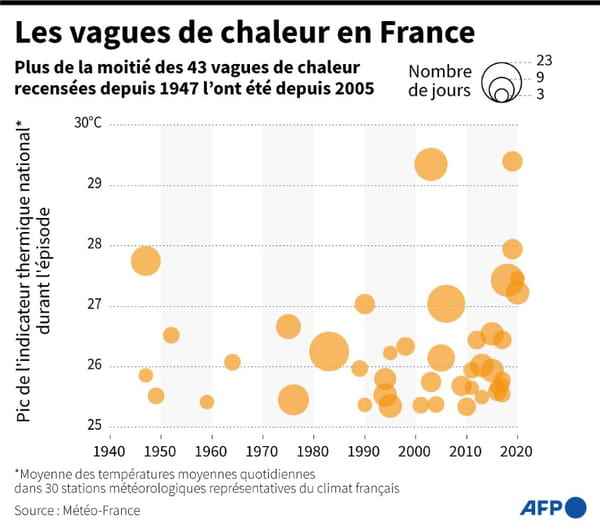Temperatures between 30 and 35°C over the entire southern half of the country, the heat wave arriving from Spain progressed on Wednesday, but the worst is yet to come with mercury which should still panic by crossing the 40 mark °C locally on Friday.
Sign of this worsening, Météo-France has activated the orange “heat wave” alert for 23 departments of a large south-west quarter, from Anjou to the Pyrenees, not to mention a heat island in Drôme / Ardèche, according to the latest Meteo-France point.
In the wake of the mass of hot air from the Maghreb via Spain, the maximum fluctuated at 3:00 p.m. between 30 and 35°C in the south of the country, according to Météo-France. And that’s just the beginning.
“From Friday, we have a panic of mercury with 40°C regularly reached in the South-West and possible as far as the Loire, as in the Rhône valley”, warns Olivier Proust, forecaster at Météo-France.
“Saturday promises to be the peak of the heat wave, with 35 to 39°C fairly generalized over a good part of the territory, from the Garonne to the northeast via the Rhône valley, the region Parisian, the Center Val-de-Loire”, insisted Tristan Amm, another forecaster at Météo-France.
Météo-France had estimated on Tuesday that only a few departments could be placed in orange vigilance, but “this has been revised upwards, we started with a more pessimistic scenario which induces warmer temperatures than what we expected yesterday (Tuesday ),” he told AFP.

Workers on a construction site cool off with water, June 14, 2022 in Mérignac, near Bordeaux
© AFP – Philippe LOPEZ
Attributed to global warming, heat waves are increasing around the world, including in France where this episode is unprecedentedly early, the earliest, ahead of those of 2017 and 2005 which began on June 18.
This heat wave “has an aggravating effect on the dryness of the soil” after a particularly dry spring and winter and increases “the risk of forest fire”, warns Mr. Proust.
In the South-East, the department of Vaucluse has been placed on ozone pollution alert – pollution resulting from the chemical transformation of other pollutants in the ambient air, under the effect of solar radiation -and the Bouches- du-Rhône will be on Thursday.
– “It’s become unlivable!” –
In this stifling context, more than 500,000 high school students worked for four hours on the dreaded test of philosophy, equipped with water in quantity, in bottles and misters, as at the Lycée Général Victor-Louis de Talence, in the suburbs of Bordeaux. , where the examination rooms were set up “on the north face”, hidden from the scorching sun.

A bottle of water on a table before the start of the baccalaureate philosophy test, June 15, 2022 in Bordeaux
© AFP – Philippe LOPEZ
Here the staff has “been very careful to choose the freshest and to ventilate since 5:30 a.m. this (Wednesday) morning”, notes Anne Bisagni-Faure, rector of the Academy of Bordeaux.
In his university residence in Toulouse, Gabriel, 19, already finds the atmosphere “unbearable”. “I can’t even open the only window in my 20 m2 apartment because it overlooks a garden where there are a lot of insects. And the bathroom ventilation hasn’t worked for three days.”
Same discomfort for Louis Layrac, 23, an apprentice in industrial maintenance in the pink city. “With the blouse, the safety shoes, it becomes unlivable”, he assures.
It’s quite the opposite for Chadi, 55, who works in agriculture or construction depending on the opportunities and who says he is “very happy”. “I am Algerian and I did my military service in the Sahara. It was 60°”, he says.
Faced with temperatures that put the bodies to the test, some companies adapt by modulating the hours, especially in the construction industry, explains Emmanuel Corbi, on a construction site in Toulouse.
“Our infrastructures are suffering because we have dilation phenomena which are linked to the temperature both in the rail and in the catenary” indicates for his part Thierry Rose, territorial manager of SNCF infrastructures at the Bordeaux St-Jean station, where 51.7°C were recorded at rail level during the day.
For their part, communities are stepping up measures to relieve residents. In Bordeaux, foggers will be installed “in squares in the city which are ovens, indicates the health and seniors assistant of the EELV town hall, Sylvie Justome.
In Lyon as in Bordeaux, two ecological municipalities, we have extended the opening hours of parks and gardens. In the Tarn, the mayor of the village of Saint-Benoît-de-Carmaux has decided to close the municipal school on Thursday and Friday, while providing a daycare service.
bur-laf-abd-nal-tsq/pjl/tes-mpm
All rights of reproduction and representation reserved. © (2022) Agence France-Presse



